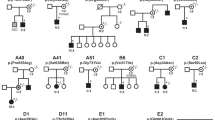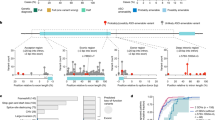Abstract
Obstructive azoospermia (OA), defined as an obstruction in any region of the male genital tract, accounts for 40% of all azoospermia cases. Of all OA cases, ~30% are thought to have a genetic origin, however, hitherto, the underlying genetic etiology of the majority of these cases remain unknown. To address this, we took a family-based whole-exome sequencing approach to identify causal variants of OA in a multiplex family with epidydimal obstruction. A novel gain-of-function missense variant in CLDN2 (c.481G>C; p.Gly161Arg) was found to co-segregate with the phenotype, consistent with the X-linked inheritance pattern observed in the pedigree. To assess the pathogenicity of this variant, the wild and mutant protein structures were modeled and their potential for strand formation in multimeric form was assessed and compared. The results showed that dimeric and tetrameric arrangements of Claudin-2 were not only reduced, but were also significantly altered by this single residue change. We, therefore, envisage that this amino acid change likely forms a polymeric discontinuous strand, which may lead to the disruption of tight junctions among epithelial cells. This missense variant is thus likely to be responsible for the disruption of the blood-epididymis barrier, causing dislodged epithelial cells to clog the genital tract, hence causing OA. This study not only sheds light on the underlying pathobiology of OA, but also provides a basis for more efficient diagnosis in the clinical setting.
Similar content being viewed by others
Log in or create a free account to read this content
Gain free access to this article, as well as selected content from this journal and more on nature.com
or
References
Wosnitzer M, Goldstein M, Hardy MP. Review of Azoospermia. Spermatogenesis. 2014;4(December):e28218.
Pastore AL, Palleschi G, Silvestri L, Leto A, Carbone A. Obstructive and non-obstructive azoospermia. Male Infertil Bashamboo, Anu. 2012;1–21.
Wosnitzer, Goldstein M. Obstructive azoospermia. Urol Clin North Am. 2014;41:83–95.
Gudeloglu A, Parekattil S. Update in the evaluation of the azoospermic male. Clinics. 2013;68(S1):27–34.
Radpour R, Gourabi H, Dizaj AV, Holzgreve W, Zhong XY. Genetic investigations of CFTR mutations in congenital absence of vas deferens, uterus, and vagina as a cause of infertility. J Androl. 2008;29:506–13.
Dohle GR, Colpi GM, Hargreave TB, Papp GK, Jungwirth A, Weidner W. EAU guidelines on male infertility. Eur Urol. 2005;48:703–11.
Hamada AJ, Esteves SC, Agarwal A. A comprehensive review of genetics and genetic testing in azoospermia. Clin (Sao Paulo). 2013;68(Suppl 1):39–60.
Poongothai J, Gopenath TS, Manonayaki S. Genetics of human male infertility. Singap Med J. 2009;50:336–47.
Fanen P, Wohlhuter-Haddad A, Hinzpeter A. Genetics of cystic fibrosis: CFTR mutation classifications toward genotype-based CF therapies. Int J Biochem Cell Biol. 2014;52:94–102.
Patat O, Pagin A, Siegfried A, Mitchell V, Chassaing N, Faguer S, et al. Truncating mutations in the adhesion G protein-coupled receptor G2 Gene ADGRG2 cause an X-linked congenital bilateral absence of vas deferens. Am J Hum Genet. 2016;99:437–42.
Uhlen M, Fagerberg L, Hallstrom BM, Lindskog C, Oksvold P, Mardinoglu A, et al. Tissue-based map of the human proteome. Sci (80-). 2015;347:1260419–1260419.
Gilissen C, Hoischen A, Brunner HG, Veltman JA. Disease gene identification strategies for exome sequencing. Eur J Hum Genet [Internet]. 2012;20:490–7. https://doi.org/10.1038/ejhg.2011.258. Available from
Okutman O, Muller J, Baert Y, Serdarogullari M, Gultomruk M, Piton A, et al. Exome sequencing reveals a nonsense mutation in TEX15 causing spermatogenic failure in a Turkish family. Hum Mol Genet. 2015;24:5581–8.
Amiri-Yekta A, Coutton C, Kherraf ZE, Karaouzène T, LeTanno P, Sanati MH, et al. Whole-exome sequencing of familial cases of multiple morphological abnormalities of the sperm flagella (MMAF) reveals new DNAH1 mutations. Hum Reprod. 2016;31:2872–80.
Guan X, Inai T, Shibata Y. Segment-specific expression of tight junction proteins, claudin-2 and -10, in the rat epididymal epithelium. Arch Histol Cytol. 2005;68:213–25.
Bashamboo A, Brauner R, Bignon-Topalovic J, Lortat-Jacob S, Karageorgou V, Lourenco D, et al. Mutations in the FOG2/ZFPM2 gene are associated with anomalies of human testis determination. Hum Mol Genet. 2014;23:3657–65.
Krause G, Protze J, Piontek J. Assembly and function of claudins: Structure-function relationships based on homology models and crystal structures. Semin Cell Dev Biol. 2015;42:3–12.
Zhang Y. I-TASSER server for protein 3D structure prediction. BMC Bioinforma. 2008;9:40.
de Vries SJ, van Dijk M. Bonvin AMJJ. The HADDOCK web server for data-driven biomolecular docking. Nat Protoc. 2010;5:883–97.
Suzuki H, Tani K, Tamura A, Tsukita S, Fujiyoshi Y. Model for the architecture of claudin-based paracellular ion channels through tight junctions. J Mol Biol. 2015;427:291–7.
Angelow S, Yu ASL. Cysteine mutagenesis to study the structure of claudin-2 paracellular pores. Ann N Y Acad Sci. 2009;1165:143–7.
Angelow S, Yu ASL. Structure-function studies of claudin extracellular domains by cysteine-scanning mutagenesis. J Biol Chem 2009;284:29205–17.
Yu ASL, Cheng MH, Coalson RD. Calcium inhibits paracellular sodium conductance through claudin-2 by competitive binding. J Biol Chem 2010;285:37060–9.
Yu ASL, Cheng MH, Angelow S, Günzel D, Kanzawa SA, Schneeberger EE. et al. Molecular basis for cation selectivity in claudin-2–based paracellular pores: identification of an electrostatic interaction site. J Gen Physiol . 2009;133:111–27.
Jungwirth A, Diemer T, Dohle GR, Giwercman A, Kopa Z, Krausz, C et al. Guidelines on male infertility. Eur Ass Urol. 2014;60:1–48.
Gunzel D, Yu ASL. Claudins and the modulation of tight junction permeability. Physiol Rev 2013;93:525–69.
Sullivan R, Mieusset R. The human epididymis: Its function in sperm maturation. Hum Reprod Update 2016;22:574–87.
Mital P, Hinton BT, Dufour JM. The blood-testis and blood-epididymis barriers are more than just their tight junctions. Biol Reprod 2011;84:851–8.
Zihni C, Mills C, Matter K, Balda MS. Tight junctions: from simple barriers to multifunctional molecular gates. Nat Rev Mol Cell Biol 2016;17:564–80.
Anderson JM, Itallie CM Van. Physiology and Function of the Tight Junction. Cold Spring Harb Perspect Biol. 2009;1:a002584.
Madhu LN, Morin PJ Protein family review The claudins. Genome Biol. 2009;10:235
Zhang JS, Liu Q, Li YM, Hall SH, French FS, Zhang YL. Genome-wide profiling of segmental-regulated transcriptomes in human epididymis using oligo microarray. Mol Cell Endocrinol. 2006;250:169–77.
Muto S, Hata M, Taniguchi J, Tsuruoka S, Moriwaki K, Saitou M, et al. Claudin-2-deficient mice are defective in the leaky and cation-selective paracellular permeability properties of renal proximal tubules. Proc Natl Acad Sci USA. 2010;107:8011–6.
Stechman MJ, Loh NY, Thakker RV. Genetic causes of hypercalciuric nephrolithiasis. Pediatr Nephrol. 2009;24:2321–32.
Acknowledgements
This work was supported in part by a grant from the Iran National Science Foundation (INSF), Royan Institute and the Institut Pasteur, Paris. The funders had no role in study design, data collection and analysis, decision to publish, or preparation of the manuscript.
Author information
Authors and Affiliations
Corresponding authors
Ethics declarations
Conflict of interest
The authors declare that they have no conflict of interest.
Additional information
Publisher’s note: Springer Nature remains neutral with regard to jurisdictional claims in published maps and institutional affiliations.
Supplementary information
Rights and permissions
About this article
Cite this article
Askari, M., Karamzadeh, R., Ansari-Pour, N. et al. Identification of a missense variant in CLDN2 in obstructive azoospermia. J Hum Genet 64, 1023–1032 (2019). https://doi.org/10.1038/s10038-019-0642-0
Received:
Revised:
Accepted:
Published:
Issue date:
DOI: https://doi.org/10.1038/s10038-019-0642-0
This article is cited by
-
The CLDN5 gene at the blood-brain barrier in health and disease
Fluids and Barriers of the CNS (2023)
-
The role of claudins in homeostasis
Nature Reviews Nephrology (2023)
-
The X chromosome and male infertility
Human Genetics (2021)



